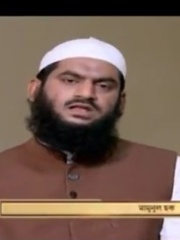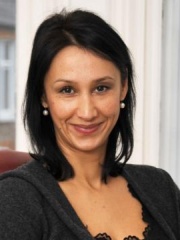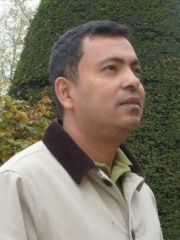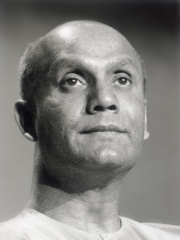
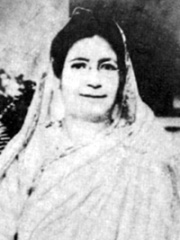
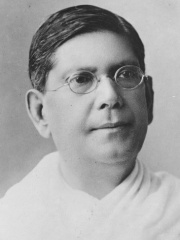
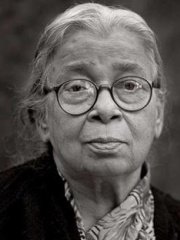
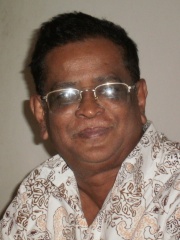
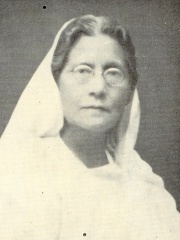
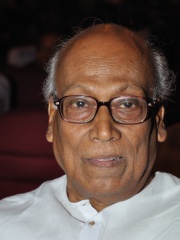
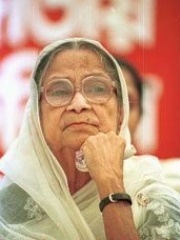
The Most Famous
WRITERS from Bangladesh
This page contains a list of the greatest Bangladeshi Writers. The pantheon dataset contains 7,302 Writers, 7 of which were born in Bangladesh. This makes Bangladesh the birth place of the 76th most number of Writers behind Senegal, and Uzbekistan.
Top 10
The following people are considered by Pantheon to be the top 10 most legendary Bangladeshi Writers of all time. This list of famous Bangladeshi Writers is sorted by HPI (Historical Popularity Index), a metric that aggregates information on a biography’s online popularity. Visit the rankings page to view the entire list of Bangladeshi Writers.

1. Sri Chinmoy (1931 - 2007)
With an HPI of 64.36, Sri Chinmoy is the most famous Bangladeshi Writer. His biography has been translated into 35 different languages on wikipedia.
Chinmoy Kumar Ghose (27 August 1931 – 11 October 2007), better known as Sri Chinmoy, was an Indian spiritual leader who taught meditation in the United States after moving to New York City in 1964. Chinmoy established his first meditation center in Queens, New York, and eventually had 7,000 students in 60 countries. He was an author, artist, poet, and musician, he also held public events such as concerts and meditations on the theme of inner peace. Chinmoy advocated a spiritual path to God through prayer and meditation. He advocated athleticism including distance running, swimming, and weightlifting. He organized marathons and other races, and was an active runner and, following a knee injury, weightlifter. Some ex-members have accused Chinmoy of running a cult.

2. Begum Rokeya (1880 - 1932)
With an HPI of 56.56, Begum Rokeya is the 2nd most famous Bangladeshi Writer. Her biography has been translated into 30 different languages.
Rokeya Sakhawat Hossain (Bengali: রোকেয়া সাখাওয়াত হোসেন; 9 December 1880 – 9 December 1932), commonly known as Begum Rokeya, was a prominent Bengali feminist thinker, writer, educator and political activist from British India. She is widely regarded as a pioneer of women's liberation in India and Bangladesh. She advocated for men and women to be treated equally as rational beings, noting that the lack of education for women was responsible for their inferior economic position. Her major works include Matichur (A String of Sweet Pearls, 1904 and 1922), a collection of essays in two volumes expressing her feminist thoughts; Sultana's Dream (1908), a feminist science fiction novella set in Ladyland ruled by women; Padmarag ("Essence of the Lotus", 1924) depicting the difficulties faced by Bengali wives; and Abarodhbasini (The Confined Women, 1931), a spirited attack on the extreme forms of purdah that endangered women's lives and self-image. Rokeya held education to be the central precondition of women's liberation, establishing the first school aimed primarily at Muslim girls in Kolkata. She is said to have gone from house to house persuading the parents to send their girls to her school in Nisha. Until her death, she ran the school despite facing hostile criticism and social obstacles. In 1916, she founded the Muslim Women's Association, an organization that fought for women's education and employment. In 1926, Rokeya presided over the Bengal Women's Education Conference convened in Kolkata, the first significant attempt to bring women together in support of women's education rights. She was engaged in debates and conferences regarding the advancement of women until her death on 9 December 1932, shortly after presiding over a session during the Indian Women's Conference. Bangladesh observes Rokeya Day on 9 December every year to commemorate her works and legacy. On that day, Bangladesh government also confers Begum Rokeya Padak on individual women for their exceptional achievement. In 2004, Rokeya was ranked number 6 in BBC's poll of the Greatest Bengali of all time.

3. Chittaranjan Das (1869 - 1925)
With an HPI of 55.44, Chittaranjan Das is the 3rd most famous Bangladeshi Writer. His biography has been translated into 25 different languages.
Chittaranjan Das (5 November 1870 – 16 June 1925), popularly called Deshbandhu (Friend of the Country or Nation), was an Indian freedom fighter, political activist and lawyer during the Indian Independence Movement and the Political Guru of Indian freedom fighter Netaji Subhas Chandra Bose. He is the founder-leader of the Swaraj Party in undivided Bengal during the period of British Colonial rule in India. His name is abbreviated as C. R. Das. He was closely associated with a number of literary societies and wrote poems, apart from numerous articles and essays.

4. Mahasweta Devi (1926 - 2016)
With an HPI of 53.37, Mahasweta Devi is the 4th most famous Bangladeshi Writer. Her biography has been translated into 33 different languages.
Mahasweta Devi (14 January 1926 – 28 July 2016) was an Indian writer in Bengali and an activist. Her notable literary works include Hajar Churashir Maa, Rudali, and Aranyer Adhikar. She was a leftist who worked for the rights and empowerment of the tribal people (Lodha and Shabar) of West Bengal, Bihar, Madhya Pradesh and Chhattisgarh states of India. She was honoured with various literary awards such as the Sahitya Akademi Award (in Bengali), Jnanpith Award and Ramon Magsaysay Award along with India's civilian awards Padma Shri and Padma Vibhushan.
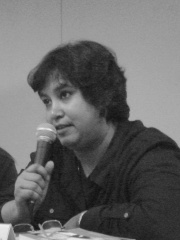
5. Taslima Nasrin (b. 1962)
With an HPI of 50.79, Taslima Nasrin is the 5th most famous Bangladeshi Writer. Her biography has been translated into 51 different languages.
Taslima Nasrin (born 25 August 1962) is a Bangladeshi writer, physician, feminist, secular humanist, and activist. She is known for her writing on women's oppression and criticism of religion; some of her books are banned in Bangladesh. She has also been blacklisted and banished from the Bengal region, both from Bangladesh and the Indian state of West Bengal. She gained global attention by the beginning of 1990s owing to her essays and novels with feminist views and criticism of what she characterizes as all "misogynistic" religions. Nasrin has been living in exile since 1994, with multiple fatwas calling for her death. After living more than a decade in Europe and the United States, she moved to India in 2004 and has been staying there on a resident permit long-term, multiple-entry or 'X' visa since. She now lives in New Delhi, India.

6. Humayun Ahmed (1948 - 2012)
With an HPI of 50.46, Humayun Ahmed is the 6th most famous Bangladeshi Writer. His biography has been translated into 17 different languages.
Humayun Ahmed ( [ɦumaiyun aɦmed]; 13 November 1948 – 19 July 2012) was a Bangladeshi novelist, dramatist, screenwriter, filmmaker, songwriter, scholar, and academic. His breakthrough was his debut novel Nondito Noroke published in 1972. He wrote over 200 fiction and non-fiction books. He was one of the most popular authors and filmmakers in post-independence Bangladesh. Pakistani English newspaper Dawn referred to him as the cultural legend of Bangladesh. In the early 1990s, Humayun Ahmed emerged as a filmmaker. He went on to make a total of eight films – each based on his novels. Some of his notable films are: Daruchini Dip, Aguner Poroshmoni, Srabon Megher Din, Shonkhonil Karagar, Dui Duari, Shyamol Chhaya and Ghetuputra Komola. He was one of the most influential dramatist in Bangladesh during the 1990s, when he wrote the most popular soap operas. His works, such as Kothao Keu Nei, Aaj Robibar, and Bohubrihi, are still considered masterpieces by fans and critics. Many Bangladeshi filmmakers are still inspired by his works. His film Shyamol Chhaya and Ghetuputra Komola were gradually submitted for the 78th Academy Awards and 85th Academy Awards in the Best Foreign Language Film category from Bangladesh. Later he set up his own production company named Nuhash Chalachitra. Widely regarded as the greatest novelist in Bangladesh's history, He is considered one of the cornerstones in modern Bengali literature, his works are characterized by non-violence, realistic storylines, family drama, and humor styles. In recognition of the works of Humayun, The Times of india wrote, "Humayun was a custodian of the Bangladeshi literary culture whose contribution single-handedly shifted the capital of Bengali literature from Kolkata to Dhaka without any war or revolution." and entitled him "The Shakespeare of Bangladesh".Sunil Gangopadhyay described him as the most popular writer in the Bengali language for a century, and according to him (Sunil), Humayun Ahmed was even more popular than Sarat Chandra Chattopadhyay. Humayun Ahmed's books have been the top sellers at the Ekushey Book Fair during every year of the 1990s and 2000s. He won the National Film Awards a record 7 times in directing, screenplay and story for the films Ghetuputra Komola, Aguner Poroshmoni, Shonkhonil Karagar, Daruchini Dwip and Anil Bagchir Ekdin. He also won the Bangla Academy Literary Award in 1981 and the Ekushey Padak in 1994 for his contribution to the Bengali literature.

7. Kamini Roy (1864 - 1933)
With an HPI of 49.85, Kamini Roy is the 7th most famous Bangladeshi Writer. Her biography has been translated into 22 different languages.
Kamini Roy (12 October 1864 – 27 September 1933) was a Bengali poet, social worker and feminist in British India. She was the first woman honours graduate in British India.

8. Shankha Ghosh (1932 - 2021)
With an HPI of 47.26, Shankha Ghosh is the 8th most famous Bangladeshi Writer. His biography has been translated into 15 different languages.
Sankha Ghosh (born Chittapriya Ghosh; 5 February 1932 – 21 April 2021) was an Indian poet and literary critic. He was born in Chandpur District of the then Bengal Presidency, present day Bangladesh. His ancestral home was at Banaripara Upazila in Barisal District. He spent his childhood and adolescence in Ishwardi Upazila of Pabna District, which was his father's workplace. Ghosh passed matriculation from Chandraprabha Vidyapitha, Pabna. He got his undergraduate degree in Arts in Bengali from Presidency College, Kolkata in 1951 and subsequently his master's degree from the University of Calcutta in the year 1954.

9. Sufia Kamal (1911 - 1999)
With an HPI of 47.06, Sufia Kamal is the 9th most famous Bangladeshi Writer. Her biography has been translated into 15 different languages.
Begum Sufia Kamal (20 June 1911 – 20 November 1999) was a Bangladeshi poet, feminist leader, and political activist. She took part in the Bengali nationalist movement of the 1950s and civil society leader in independent Bangladesh. She led feminist activism and was a president of Bangladesh Mahila Parishad. She died in 1999 and was the first woman to be given a state funeral in Bangladesh.
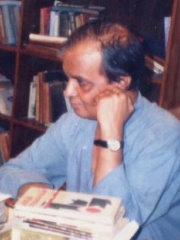
10. Ahmed Sofa (1943 - 2001)
With an HPI of 46.60, Ahmed Sofa is the 10th most famous Bangladeshi Writer. His biography has been translated into 15 different languages.
Ahmed Sofa (Bengali: আহমদ ছফা, pronounced [aɦmɔd sɔfa]; 30 June 1943 – 28 July 2001) was a Bangladeshi writer, thinker, novelist, poet, philosopher and public intellectual. Sofa is considered by many, including National Professor Abdur Razzaq and Salimullah Khan, to be the most important Bengali Muslim writer after Mir Mosharraf Hossain and Kazi Nazrul Islam. A writer by occupation, Sofa wrote 18 non-fiction books, 8 novels, 4 collections of poems, 2 collections of short stories, and several books in other genres. Sofa's Bangali Musalmaner Man (The Mind of the Bengali Muslims, 1981) is a highly acclaimed critical survey of the formation of Bengali Muslims' identity, causes of their backwardness, their development as a community, and their intellectual progress. Anisuzzaman and many others consider Sofa's Bangali Musalmaner Man one of the greatest non-fiction books written in the Bengali language. In Buddhibrittir Natun Binyas (A New Mode of Intellectualism, 1972), Sofa mapped the intellectual landscape of Bangladesh, delineating general opportunistic tendencies of Bangladeshi intellectuals, their collaboration with the Establishment, and their failure to bring any real material change in postcolonial Bangladesh. Characterized by “a freshness of language”, and "constant experimentation, and novelty" of subject matter and narration, his fictions portrayed Bangladesh with all its social, spiritual and political nuances. Critics acclaimed his intricate characterization depicting psychological and sociocultural subtleties with realism. Abul Fazal, and many others considered Sofa's Omkar (The Om, 1975) the best literary expression of the liberation movement of Bangladesh. Gabhi Bittanta (A Tale of a Cow, 1995), a novel satirizing university teachers involved in party politics and corruption is among the best satires in Bengali literature. Pushpa Briksa ebang Bihanga Puran (Tales of Flowers, Trees, and Birds, 1996) recounts Sofa's spiritual attachments with birds, plants and trees reflecting his profound biophilia and ecoconsciousness. Some of his long poems include Ekti Prabeen Bater Kache Prarthana (Prayer to an Ancient Banayan Tree, 1977), and Basti Ujar (The Eviction of the Shanti Town Dwellers), etc. Sofa and his works guided, inspired, influenced, and continue to inspire and influence many writers, filmmakers, painters, artists, and intellectuals including Humayun Ahmed, Muhammed Zafar Iqbal, Tareque Masud, Farhad Mazhar, Salimullah Khan, etc. He remains one of the most powerful intellectual influences in Bangladesh through his works and legacy. For a bohemian lifestyle, and outspoken nature, Sofa was a controversial figure during his lifetime. He was called rebel, mad, insolent, devoid of respect for authority, and an overly uncompromising figure among the intellectuals. Never to be co-opted by the establishment, Sofa rejected Lekhak Shibir Award in 1975, and Sa'dat Ali Akanda Award offered by Bangla Academy in 1993. He was awarded Ekushe Padak posthumously by the Government of Bangladesh in 2002.
People
Pantheon has 13 people classified as Bangladeshi writers born between 1864 and 1973. Of these 13, 3 (23.08%) of them are still alive today. The most famous living Bangladeshi writers include Taslima Nasrin, Mamunul Haque, and Monica Ali. The most famous deceased Bangladeshi writers include Sri Chinmoy, Begum Rokeya, and Chittaranjan Das. As of April 2024, 4 new Bangladeshi writers have been added to Pantheon including Humayun Ahmed, Shankha Ghosh, and Sufia Kamal.
Living Bangladeshi Writers
Go to all RankingsTaslima Nasrin
1962 - Present
HPI: 50.79
Mamunul Haque
1973 - Present
HPI: 33.92
Monica Ali
1967 - Present
HPI: 32.74
Deceased Bangladeshi Writers
Go to all RankingsSri Chinmoy
1931 - 2007
HPI: 64.36
Begum Rokeya
1880 - 1932
HPI: 56.56
Chittaranjan Das
1869 - 1925
HPI: 55.44
Mahasweta Devi
1926 - 2016
HPI: 53.37
Humayun Ahmed
1948 - 2012
HPI: 50.46
Kamini Roy
1864 - 1933
HPI: 49.85
Shankha Ghosh
1932 - 2021
HPI: 47.26
Sufia Kamal
1911 - 1999
HPI: 47.06
Ahmed Sofa
1943 - 2001
HPI: 46.60
Avijit Roy
1972 - 2015
HPI: 34.26
Newly Added Bangladeshi Writers (2024)
Go to all RankingsHumayun Ahmed
1948 - 2012
HPI: 50.46
Shankha Ghosh
1932 - 2021
HPI: 47.26
Sufia Kamal
1911 - 1999
HPI: 47.06
Ahmed Sofa
1943 - 2001
HPI: 46.60
Overlapping Lives
Which Writers were alive at the same time? This visualization shows the lifespans of the 10 most globally memorable Writers since 1700.

